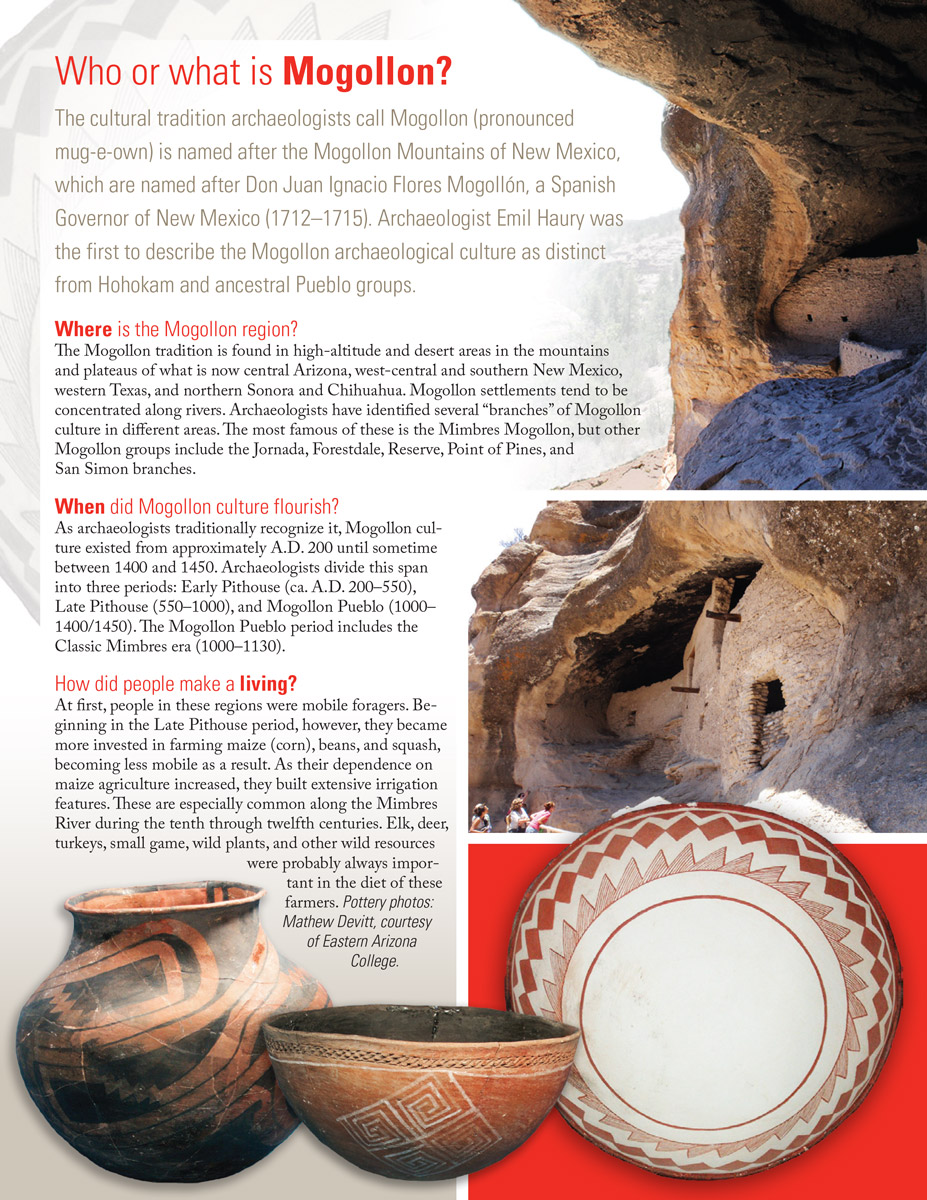
The cultural tradition archaeologists call Mogollon (pronounced mug-e-own) is named after the Mogollon Mountains of New Mexico, which are named after Don Juan Ignacio Flores Mogollón, a Spanish Governor of New Mexico (1712–1715). Archaeologist Emil Haury was the first to describe the Mogollon archaeological culture as distinct from Hohokam and ancestral Pueblo groups.
Where is the Mogollon region?
The Mogollon tradition is found in high-altitude and desert areas in the mountains and plateaus of what is now central Arizona, west-central and southern New Mexico, western Texas, and northern Sonora and Chihuahua. Mogollon settlements tend to be concentrated along rivers. Archaeologists have identified several “branches” of Mogollon culture in different areas. The most famous of these is the Mimbres Mogollon, but other Mogollon groups include the Jornada, Forestdale, Reserve, Point of Pines, and San Simon branches.
When did Mogollon culture flourish?
As archaeologists traditionally recognize it, Mogollon culture existed from approximately A.D. 200 until sometime between 1400 and 1450. Archaeologists divide this span into three periods: Early Pithouse (ca. A.D. 200–550), Late Pithouse (550–1000), and Mogollon Pueblo (1000–1400/1450). The Mogollon Pueblo period includes the Classic Mimbres era (1000–1130).
How did people make a living?
At first, people in these regions were mobile foragers. Beginning in the Late Pithouse period, however, they became more invested in farming maize (corn), beans, and squash, becoming less mobile as a result. As their dependence on maize agriculture increased, they built extensive irrigation features. These are especially common along the Mimbres River during the tenth through twelfth centuries. Elk, deer, turkeys, small game, wild plants, and other wild resources were probably always important in the diet of these farmers.
What is important to know about Mogollon culture? How did it change through time?
During the Early Pithouse period, people tended to live in upland locations, building deep circular, oval, or amorphous pithouses, often with ramps or vestibules. They clustered these dwellings in small groups. People made brown pottery using the coil-and-scrape method, sometimes covering vessels with a red slip.
Around A.D. 550, at the beginning of the Late Pithouse period, groups shifted their settlement locations down to the first flat terraces above river floodplains. Pithouse forms shifted over time, ultimately becoming rectangular. Late Pithouse villages were large, with dozens of pit structures clustered together around a larger, more elaborate ceremonial pit structure. In this era, people also developed red-on-brown painted pottery, followed by white-on-red, which was in turn followed by black-on-white.
Beginning around 1000, people in these regions began living in aboveground stone pueblos. Later in the Mogollon Pueblo period, there was a great deal of regional diversity in architecture, which could be of masonry or adobe construction, and in pottery, which embodies a variety of painted black-on-white and polychrome traditions. Villages were usually located on valley floors near good agricultural land.
Cliff dwellings, such as those at southwestern New Mexico’s Gila Cliff Dwellings National Monument (see images on front side), became more common during the 1200s and 1300s. The large adobe pueblos of the Upper Gila River and its tributaries (1200s–1400s), as well as the masonry pueblos of the Mogollon Rim area in Arizona (1200s–1300s), are some of the last in the Mogollon region with large populations. Although much of the area where we find Mogollon culture was subsequently inhabited by more mobile groups, such as the Apache, many modern-day Pueblo people believe that Mogollon traditions are part of their heritage, and archaeology bears this out.
What new Mogollon research is underway?
Several Mogollon archaeological sites from a number of different time periods have recently been investigated by researchers from the University of Arizona, Arizona State University, the University of Colorado, and the University of Oklahoma, to name a few. Current work by Dr. Barbara Roth (University of Nevada, Las Vegas) builds upon Emil Haury’s original investigations at the Harris site, exploring community organization and social integration through time.
Part of Archaeology Southwest’s recent research on migration, community development, and the spread of Salado ideology in the 1300–1400s focuses on several large adobe pueblos in the Mogollon region. These investigations are not only providing new data on the diversity of Mogollon traditions, but also offering new opportunities for public outreach and site protection.
Want to learn more? Explore the major concepts, places, cultures, and themes that Southwestern archaeologists are investigating today in our Introduction to Southwestern Archaeology.